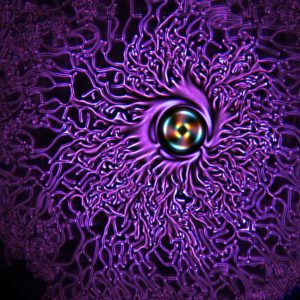Branching Liquid Crystal Drops
This study, published in Nature, discovered that droplets containing chain-like liquid crystal molecules change shape from spheres into a stunning array of complex shapes, from “flowers” that resemble microscopic chrysanthemums to massive “Medusa” networks of intertwining fibers. The shape transitions are reversible too—droplets can go from spheres to tangled networks and then back again. The shape of the droplet is driven by surface tension, the tendency of fluid surfaces to shrink into the smallest area possible, and elastic energy, the mechanical energy stored in bendable objects like bed springs or an archer’s bow. To keep surface energy to a minimum, the liquid crystal droplet normally forms a sphere, the shape with the smallest surface-to-volume ratio. Inside these droplets, however, the individual liquid-crystal rod-like molecules want to be both perpendicular to the sphere’s surface while also sitting parallel with other rods. The complex interplay of these interactions led to the shape transitions. Besides the remarkable drop shapes, one of the surprising findings of this work was that the key to this strange phenomenon was having both long-chain and short-chain rods in the drop—in scientific terms, having a liquid crystal system with polydispersity. When the rod-like mesogens were of similar length, no effects were seen, but if they had many different lengths, then the rods would move to different places inside the droplet based on their length and trigger the shape-change effects. This research was conducted by Wei-Shao Wei, Sophie Ettinger, Yu Xia, in the labs of Shu Yang, and Arjun Yodh.
Beautiful Science page

